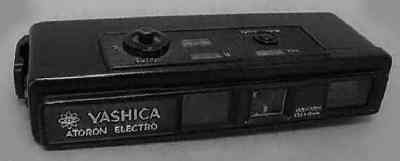

Yashica Atoron Electro
In 1970, Yashica came out with an updated version of the original Atoron -- with BIG changes -- and called
it the Atoron Electro. The lens was the same -- a Yashinon-DX f/2.8-13.0 18mm composed of four
elements in three groups, but now it was a focusing lens -- from 2 feet to infinity. The Atoron Electro
swapped out the original selenium meter for a CdS meter with ASA settings of 16, 25, 50, 100
and 200. Another change is that the exposure control is fully automatic -- unlike the original. The
aperture settings and shutter speeds are fully controlled by the CdS cell in a programmed automatic mode --
from f2.8 at 8 seconds to f13 at 1/350 second -- similar to Yashica's Electro 35mm ranginders. The shutter is electronic,
so without a battery the camera will not operate. There are no manual settings of exposure, other than
changing the ISO setting, however . The Electro is a bit larger than the Minox subminis, but not by much.
Its weight is only 140 grams including the battery; its dimensions are 4.8 x 0.75 x l.5 inches.
You can press a button to check whether or not the speed is going to be longer than 1/30s. If it is, a light
will appear in a small window above the viewfinder window. The light is bright enough and there is enough "spill",
so it's not necessary to take your eye away from the viewfinder. Yashica offered, optionally, a tripod attachment
that will permit use of the camera on any standard tripod. There's also a small table-top four-legged stand that
can be collapsed for easy portability. Another useful accessory is the Grip/Tripod ST-9, a miniature lightweight
tripod that can be used as a wall support, grip-pod, etc.
Loading the camera with a Minox-type cassette is not a problem, but you have to remember to pull the film advance tab halfway out to open the pressure plate. There's a small detent notch at that point that will hold it in position so you don't have a three-handed operation. After that, it's just a matter of setting the ASA film speeds, advancing the film to "1", and shooting. The shutter release on the Atoron is extremely light, and Yashica has wisely put a lock position on it so that you don't accidentally take a shot of the interior of your coat pocket.
As mentioned, this is a focusing lens. Focusing is by guestimation, or actual measurement: turn a small thumb wheel on the bottom of the camera until the proper footage shows on the top. Close focusing of the Atoron is two feet, which gives a good head shot. To help things out, the viewfinder has automatic parallax correction.
The camera offers automatic flash exposure of subjects over a distance from 7 to 15 feet. The screw-on flash unit (taking AG-1 or AG-1B bulbs) has a nifty pop-up reflector for compactness, and a bulb ejector for ease of operation. However, watch how you handle the camera-and-flash combination: the hold of the single joining screw is tenuous, and you could possibly pull it out and strip the threads. Other accessories are a leather pouch, right-angle finder (you can play super spy), a chain strap (in case you don't want to carry the camera in your pocket), and a lens cap (that has conversion scales for ASA to DIN, and meters to feet). Then there are the aforementioned tripods, a series of filters (ND4, Y2, and 8OB) that cover the lens and meter, a set of two close-up lenses for focusing down to 20cm and 40cm, a self-timer, nylon strap, and an enlarging lens unit (sometimes called an ENLA head).
The original price of the Yashica Atoron Electro with strap, case, right-angle finder, flash gun, and batteries was $145 -- that's $1,200 in 2025 dollars. There were at least two "versions" of the Electro. The differences were apparently small, for example, one had a low-light check button while another had a rectangular, sliding low-light lever. There may be other differences as well. Whatever, they all use a six-volt DX28N, 544 silver-oxide battery or equivalent.
COPYRIGHT @ 1995-2025 by Joe McGloin. All Rights Reserved.